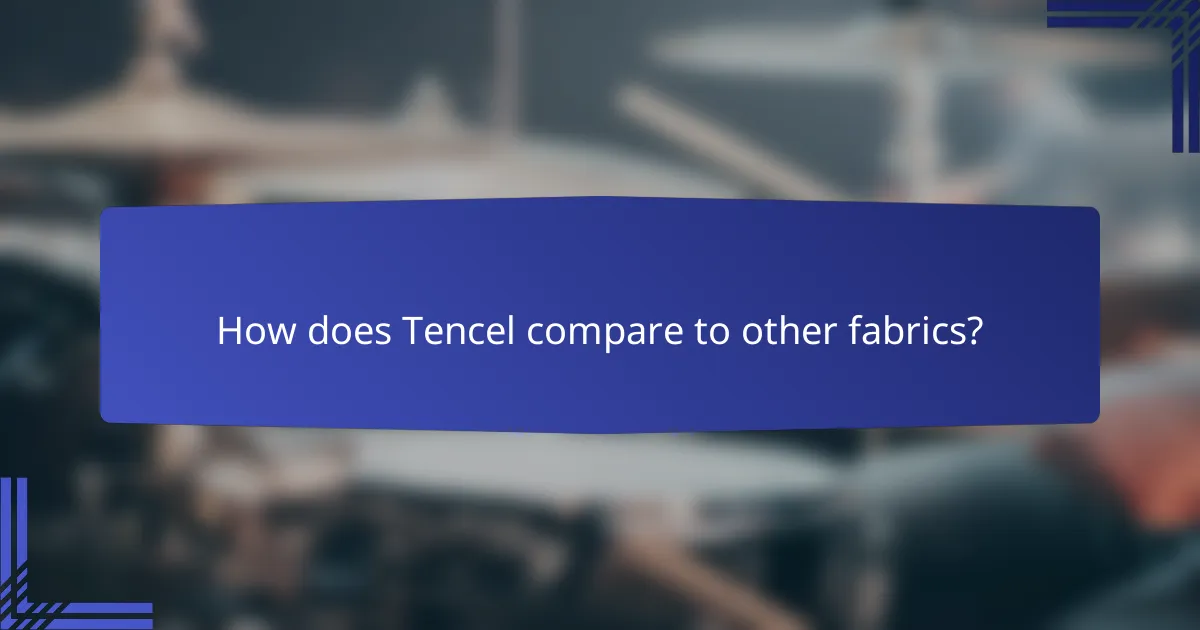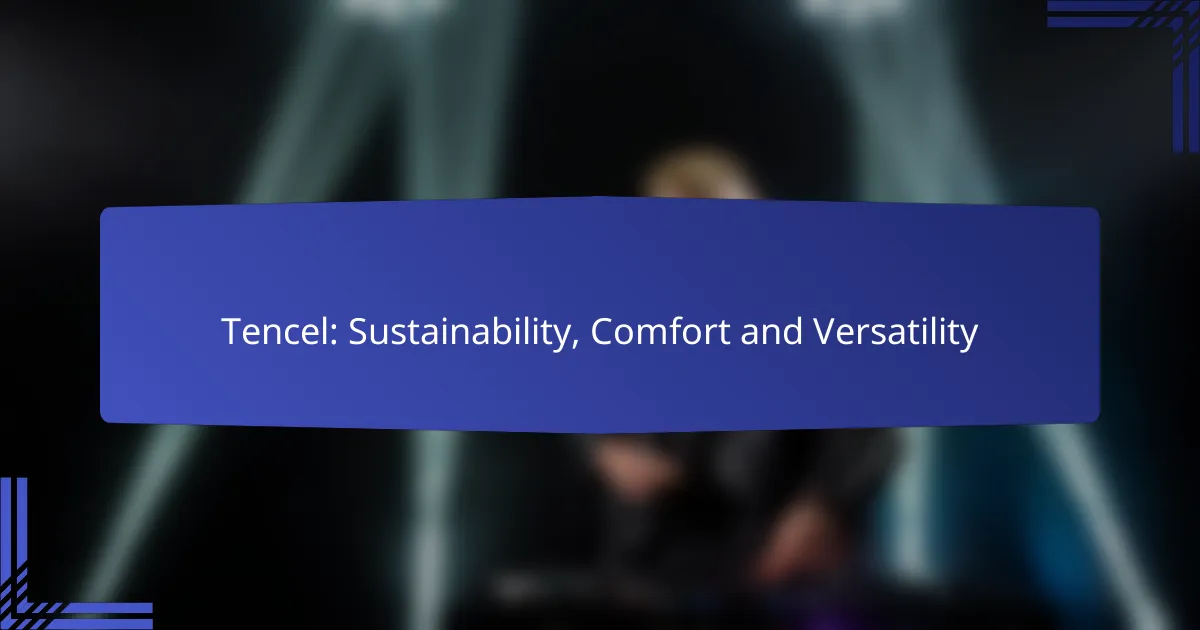Tencel is a sustainable fabric made from responsibly sourced wood pulp, designed to minimize environmental impact and promote biodegradability. Known for its exceptional comfort, Tencel features a soft texture and moisture-wicking properties, making it ideal for clothing and bedding. Its versatility allows it to be used across various industries, enhancing products with its breathability and softness.

How does Tencel contribute to sustainability?
Tencel contributes to sustainability through its eco-friendly production methods, which prioritize minimal environmental impact. This fabric is derived from sustainably sourced wood pulp and is designed to be biodegradable, making it a responsible choice for consumers concerned about their ecological footprint.
Biodegradable production process
The production process of Tencel is designed to minimize waste and environmental harm. The fibers are created using a closed-loop system that recycles water and solvents, ensuring that harmful chemicals are not released into the environment. This process allows Tencel to decompose naturally, reducing landfill contributions.
When Tencel products reach the end of their life cycle, they can break down within a few months under the right conditions, unlike synthetic fibers that can take hundreds of years to decompose. This biodegradability is a significant advantage for eco-conscious consumers.
Reduced water usage
Tencel production is notably water-efficient compared to conventional cotton farming. It uses a fraction of the water required for traditional textile manufacturing, often cited as being up to 50% less. This reduction is crucial in regions facing water scarcity.
Additionally, the closed-loop process recycles water, further minimizing overall consumption. This sustainable approach helps preserve vital water resources while still producing high-quality fabrics.
Responsible sourcing of raw materials
Tencel fibers are sourced from sustainably managed forests, ensuring that the wood pulp used is derived from trees grown in an environmentally responsible manner. These forests are certified by organizations such as the Forest Stewardship Council (FSC), which promotes sustainable forestry practices.
By choosing Tencel, consumers support responsible forestry and contribute to the preservation of biodiversity. This sourcing strategy not only protects ecosystems but also helps mitigate climate change by maintaining healthy forests that absorb carbon dioxide.

What are the comfort benefits of Tencel?
Tencel offers exceptional comfort through its soft texture, moisture-wicking properties, and temperature regulation capabilities. These features make it a popular choice for clothing and bedding, enhancing the overall user experience.
Soft texture comparable to silk
The softness of Tencel is often compared to silk, providing a luxurious feel against the skin. This smooth texture reduces friction, making it ideal for sensitive skin and minimizing irritation during wear.
Garments made from Tencel drape beautifully, enhancing comfort while maintaining a stylish appearance. This quality makes it suitable for a variety of clothing items, from casual wear to elegant dresses.
Moisture-wicking properties
Tencel’s moisture-wicking capabilities allow it to absorb and release moisture effectively, keeping the wearer dry and comfortable. This is particularly beneficial for activewear and sleepwear, as it helps regulate sweat and humidity levels.
By drawing moisture away from the body, Tencel helps prevent the growth of bacteria and odors, making it a practical choice for everyday use. This feature is especially appreciated in warmer climates or during physical activities.
Temperature regulation capabilities
Tencel is known for its ability to regulate temperature, providing warmth in cooler conditions and a cooling effect in warmer weather. This adaptability makes it suitable for year-round wear, enhancing comfort regardless of the season.
The fiber’s breathability allows for better air circulation, which contributes to a more comfortable sleeping environment. This is particularly advantageous for those who tend to sleep hot or experience temperature fluctuations during the night.

How versatile is Tencel in applications?
Tencel is highly versatile, making it suitable for a wide range of applications across various industries. Its unique properties, such as breathability, moisture-wicking, and softness, enhance its usability in clothing, home textiles, and fabric blends.
Used in clothing and activewear
Tencel is increasingly popular in clothing and activewear due to its comfort and moisture management. It effectively wicks away sweat, keeping the wearer dry during physical activities. This makes it an excellent choice for sportswear, yoga pants, and casual clothing.
Additionally, Tencel’s smooth texture reduces friction against the skin, minimizing irritation during movement. Brands often blend Tencel with other fibers to enhance stretch and durability, resulting in high-performance garments.
Ideal for home textiles and bedding
In home textiles, Tencel is favored for its luxurious feel and breathability, making it ideal for bedding and curtains. Its natural moisture-wicking properties help regulate temperature, ensuring a comfortable sleep environment. Tencel sheets and pillowcases are often softer and more durable than traditional cotton options.
Moreover, Tencel is biodegradable and produced from sustainably sourced wood, appealing to environmentally conscious consumers. This aligns with growing trends towards eco-friendly home products.
Suitable for various fabric blends
Tencel’s versatility extends to its compatibility with various fabric blends, enhancing the performance and feel of textiles. It can be blended with cotton, wool, or synthetic fibers to improve softness, durability, and moisture management. These blends often result in fabrics that are more resilient and comfortable than their individual components.
When considering fabric blends, look for Tencel percentages that balance performance with cost. A blend of 30-50% Tencel can provide significant benefits while maintaining affordability, making it a practical choice for manufacturers and consumers alike.

What are the key factors when choosing Tencel products?
When selecting Tencel products, consider factors such as fabric weight and thickness, as well as how well Tencel blends with other fibers. These elements significantly impact the comfort, durability, and overall performance of the fabric.
Fabric weight and thickness
Fabric weight and thickness are crucial when choosing Tencel products, as they influence the feel and suitability for different uses. Lightweight Tencel fabrics are often preferred for breathable summer clothing, while heavier options may be better for cooler weather or more structured garments.
Typically, Tencel fabric weights range from around 100 to 300 grams per square meter (gsm). A weight of 150-200 gsm is common for versatile clothing, balancing comfort and durability. Always check the specifications to ensure the fabric meets your needs.
Blend compatibility with other fibers
Tencel is known for its excellent compatibility with various fibers, enhancing the qualities of blended fabrics. Common blends include Tencel with cotton, wool, or polyester, which can improve breathability, moisture-wicking, and softness.
When choosing a blend, consider the desired characteristics. For instance, a Tencel-cotton blend can provide the softness of cotton with the moisture management of Tencel, making it ideal for casual wear. Always verify the fiber content to ensure it aligns with your comfort and performance expectations.

How does Tencel compare to other fabrics?
Tencel is often considered superior to many traditional fabrics due to its sustainability, comfort, and versatility. Compared to cotton and polyester, Tencel offers unique benefits that cater to environmentally conscious consumers and those seeking high-quality textiles.
Tencel vs. cotton: sustainability comparison
Tencel, made from sustainably sourced wood pulp, is produced in a closed-loop process that recycles water and solvents, minimizing environmental impact. In contrast, conventional cotton farming often requires significant water and pesticide use, which can harm ecosystems.
While organic cotton is a more sustainable option, Tencel generally has a lower carbon footprint and uses less water overall. This makes Tencel a preferable choice for eco-friendly consumers looking to reduce their environmental impact.
Tencel vs. polyester: comfort and durability
Tencel is known for its softness and breathability, providing a comfortable wearing experience that is often superior to polyester. While polyester can be durable, it tends to trap heat and moisture, making it less suitable for warm weather or active use.
In terms of durability, Tencel fibers are strong and resistant to wrinkles, but they may not match the longevity of high-quality polyester in certain applications. For everyday wear, Tencel offers a balance of comfort and durability, making it a versatile option for various clothing types.

What are the care instructions for Tencel items?
Tencel items require specific care to maintain their quality and longevity. Generally, they should be washed gently and dried with care to preserve their softness and durability.
Washing guidelines for longevity
When washing Tencel, use a gentle cycle with cold water to prevent damage. It’s advisable to use a mild detergent, as harsh chemicals can affect the fiber’s integrity. Avoid mixing with heavier fabrics that may cause abrasion.
For best results, consider hand washing or using a mesh laundry bag if machine washing. This helps minimize friction and extends the life of your Tencel garments.
Drying and ironing recommendations
After washing, air drying is the preferred method for Tencel items. Lay them flat or hang them to dry, avoiding direct sunlight to prevent fading. If using a dryer, select a low heat setting to reduce the risk of shrinkage.
When ironing, use a low temperature setting and a pressing cloth to protect the fabric. Tencel can wrinkle, but a light steam can help smooth out any creases without damaging the fibers.
